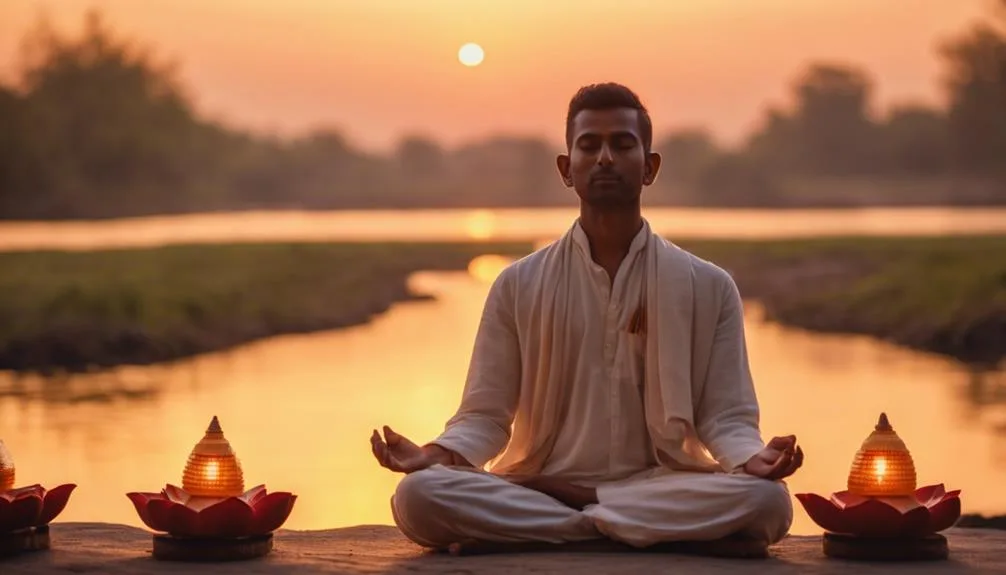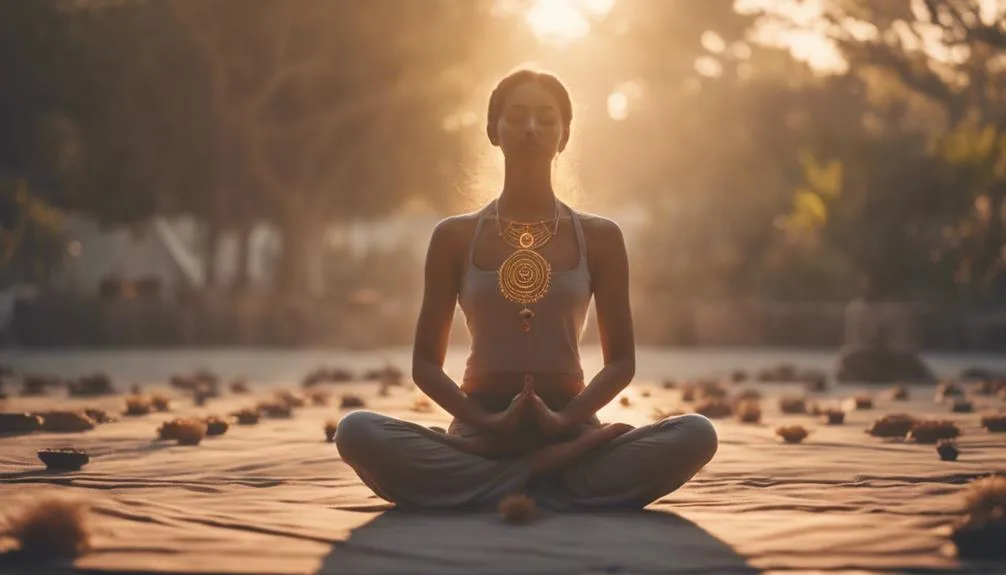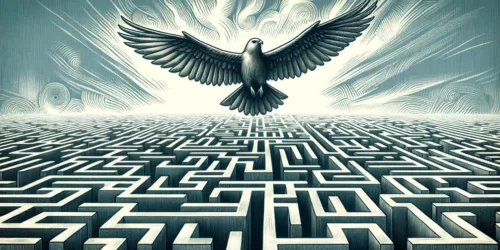Incorporating Mindfulness Into Hindu Rituals: a How-To Guide
Is it possible that incorporating mindfulness into your Hindu rituals could transform your spiritual journey?
You've likely heard that mindfulness can deepen your connection to the present moment, enhancing self-awareness and inner peace.
But how exactly do you weave it into practices like Yoga, Pranayama, or daily Puja?
As you explore this guide, you'll discover practical steps to infuse mindfulness into your spiritual routine, enriching your path to Moksha.
The key lies in understanding the subtle art of being fully present, even in the midst of age-old rituals.
Stick around to uncover how this blend of ancient wisdom and mindfulness can revolutionize your spiritual practice.
Key Takeaways
- Mindfulness in Hindu rituals enhances spiritual experience and inner peace through focused participation.
- Practices like Dhyana, Pranayama, and Yoga are essential for cultivating mindfulness in rituals.
- Incorporating mindfulness into daily rituals deepens the connection with the divine and fosters spiritual growth.
- Benefits of mindfulness include improved concentration, mental clarity, and a deeper spiritual understanding.
Understanding Mindfulness
To truly grasp the essence of mindfulness in Hindu rituals, it's crucial to recognize that it's about being fully engaged and present in the moment, allowing you to connect deeply with the spiritual practice. The practice of mindfulness isn't just about silent meditation or stillness; it's an active participation in each moment of the ritual, focusing intently on the sensations, thoughts, and emotions that arise. This attentiveness enhances the spiritual experience immeasurably.
By directing your awareness to the present, you cultivate a profound sense of gratitude, reverence, and inner peace. These qualities aren't incidental; they're at the heart of the practice of mindfulness. Through this practice, you learn to observe your mind without judgment, embracing each moment with an open heart and a tranquil mind.
Immersing yourself in the sacred moment of a ritual isn't merely about performing actions or reciting mantras; it's about experiencing the depth of connection to the divine. This deep connection is what transforms an ordinary ritual into a powerful spiritual journey. Mindfulness, in this context, becomes a bridge to the divine, enriching your spiritual life beyond measure.
Mindfulness in Hinduism
Mindfulness in Hinduism serves as a cornerstone for personal transformation, deeply rooting your spiritual practice in the present moment to foster self-awareness and inner peace. Central to this tradition is the principle that by focusing on the present, you deepen your spiritual connections and enhance your self-awareness, pivotal for personal growth and attaining inner peace. This practice isn't isolated; it's interwoven in various Hindu practices, including yoga, meditation, and rituals, all aiming to cultivate a refined state of attention control, mental clarity, and emotional balance.
Incorporating mindfulness into daily rituals allows you to experience a heightened sense of awareness and a more profound connection with the divine. It transforms routine prayers, offerings, and ceremonies into moments of intense spiritual alignment and gratitude. The Yoga Sutras, an ancient text foundational to Hindu philosophy, underscores the importance of mindfulness in achieving a state of focused concentration, leading to a deeper understanding of oneself and the universe.
The Role of Dhyana

Dhyana, a pivotal practice in Hindu rituals, involves the disciplined meditation that sharpens your focus and clears your mind, playing a crucial role in enhancing your spiritual journey. This form of meditation, deeply rooted in mindfulness, demands that you train your mind to achieve a state of profound clarity and focus. It's about transcending the ordinary fluctuations of consciousness and dissolving the patterns of negative thought that often cloud our minds.
Through the practice of Dhyana, you're not just participating in a ritual; you're embarking on a journey toward mental freedom and emotional understanding. This aspect of mindfulness in Hinduism shares similarities with Buddhist meditation, emphasizing the importance of inner peace and spiritual growth. By cultivating a tranquil state of mind, Dhyana promotes an environment where spiritual connections deepen, allowing you to explore the depths of your own self-awareness.
Practicing Dhyana within Hindu rituals is more than a mere exercise; it's a transformative experience that enhances your spiritual path. It's about finding that quiet space within yourself, where you can connect with the divine in a more meaningful and profound way. Through this disciplined meditation, you're not only sharpening your focus but also cultivating a sense of inner peace that's essential for your spiritual growth.
Pranayama Techniques
Harnessing the power of breath through Pranayama techniques, you'll discover an essential tool for enhancing mindfulness and deepening your meditation practice within Hindu rituals. Breathing techniques are pivotal in creating a serene mental state, allowing you to connect more profoundly with your spiritual practices.
Consider these essential Pranayama techniques to integrate into your rituals:
- Anulom Vilom: This alternating nostril breathing not only balances the left and right hemispheres of the brain but also purifies the energy channels, setting a perfect stage for meditation.
- Kapalbhati: Known for its invigorating effects, this technique involves short, powerful exhales and passive inhales. Kapalbhati cleanses the body, increases oxygen flow, and revitalizes the mind, preparing it for focused ritualistic practices.
- Bhramari: Mimicking the gentle humming of a bee, Bhramari calms the mind, reducing stress and anxiety. This technique is especially beneficial for attaining mental clarity and peace before conducting rituals.
- Deep Diaphragmatic Breathing: This foundational technique encourages full oxygen exchange and promotes a calm, meditative state by reducing the heart rate and lowering blood pressure.
Incorporating these Pranayama techniques into your rituals won't only enhance your mindfulness but also foster a deeper spiritual connection, enriching your practice and overall well-being.
Yoga for Mindful Rituals

Incorporating simplified breathing techniques, such as Pranayama, into your yoga regime, you'll notice a significant enhancement in your concentration during Hindu rituals.
By focusing on specific asanas, you cultivate a deeper connection between your body and mind, which is essential for achieving a heightened sense of mindfulness and presence.
The integration of post-practice relaxation rituals further prepares you for engaging in spiritual practices with a calm and focused demeanor, enriching your overall experience.
Breathing Techniques Simplified
To enhance mindfulness during Hindu rituals, you should start by practicing diaphragmatic breathing, focusing on deep abdominal breaths for relaxation and concentration. This foundational technique sets the stage for more advanced breathing exercises that intertwine seamlessly with meditation practices.
- Alternate Nostril Breathing (Nadi Shodhana): Balances energy channels, calms the mind, and promotes mental clarity.
- Bhramari Pranayama (Bee Breath): Reduces stress, quiets the mind, and cultivates inner peace.
- Kapalabhati Pranayama (Skull Shining Breath): Invigorates the body, increases focus, and prepares the mind for deeper spiritual engagement.
- Sitali Pranayama (Cooling Breath): Calms the nervous system, reduces anxiety, and creates inner coolness.
Asanas for Concentration Enhancement
After exploring the foundational breathing techniques for enhancing mindfulness, we now turn our attention to specific yoga asanas that further improve concentration and focus during Hindu rituals.
| Asana | Benefit for Mental Focus |
|---|---|
| Padmasana (Lotus Pose) | Enhances stillness and concentration |
| Vajrasana (Thunderbolt Pose) | Promotes mental clarity and focus |
| Tadasana (Mountain Pose) | Strengthens presence and alertness |
| Virabhadrasana (Warrior Pose) | Boosts confidence and determination |
| Bhujangasana (Cobra Pose) | Opens up chest for better breathing |
Incorporating these asanas into your routine before participating in rituals can significantly heighten your mental focus. By dedicating time to practice, you'll find yourself more present, aware, and engaged in the mindful observance of Hindu rituals.
Post-Practice Relaxation Rituals
Engaging in gentle yoga poses as part of your post-practice relaxation rituals can significantly unwind your body and calm your mind, offering a smooth transition from the heightened state of mindfulness achieved during your ritual practices. This approach allows you to delve deeper into your true nature, fostering a serene end to your spiritual journey.
Consider incorporating:
- Pranayama deep breathing techniques to release tension and refine your focus on the present moment.
- Restorative yoga poses like Child's Pose, Corpse Pose, or Legs Up the Wall to encourage both physical and mental relaxation.
- Mindful movement to maintain a meditative state and extend mindfulness benefits into daily activities.
- A brief meditation or savasana to integrate your practice fully and transition peacefully back into your day.
Daily Puja With Awareness

Initiating your daily puja with mindfulness involves creating a sacred space that invites spiritual connection through carefully chosen elements like candles, incense, and flowers. This setting isn't just about aesthetics; it's about cultivating an environment where your mind can focus, fostering a sense of inner peace. As you light the candles and incense, let their glow and scent serve as reminders to bring your full attention to the present moment.
Moving through each part of the puja, engage consciously with the rituals. When offering flowers or food, contemplate their symbolism and the generosity behind these acts. Chanting mantras isn't merely reciting words; it's an opportunity to feel the resonance of sacred sounds within you, allowing their vibrations to foster a deeper spiritual connection.
As you present your prayers and gratitude, do so with a calm and focused mind. This isn't just about speaking to the divine; it's about truly listening, opening yourself up to receive guidance and blessings. Concluding with a moment of silence allows you to absorb the profundity of the experience. Within this quietude, acknowledge the divine presence that surrounds and permeates, grounding yourself in mindfulness and the tranquility it brings.
Observing Vrats Mindfully
In observing Vrats mindfully, you begin by setting a clear intention that guides your spiritual journey during the fast.
By engaging in fasting practices with full awareness, you not only honor the tradition but also foster self-discipline and deeper inner reflection.
After completing the Vrat, reflecting on your experiences and expressing gratitude can further enhance your spiritual growth and understanding.
Setting Intention for Vrats
Setting an intention for a vrat requires you to thoughtfully choose a goal or purpose, aligning your actions with your spiritual journey and enhancing your mindfulness throughout the fasting period. Here's how you can mindfully set intentions for your vrat to maximize its spiritual benefits:
- Reflect on the vrat's significance and its spiritual benefits to deepen your understanding and commitment.
- Use prayer or meditation to focus your mind and heart on your chosen goal, inviting clarity and purpose.
- Contemplate how this vrat aligns with your spiritual aspirations, fostering a more meaningful practice.
- Consciously establish your intention, allowing it to guide your actions and thoughts, inviting inner transformation and a deeper spiritual connection.
Mindful Fasting Practices
By mindfully observing Vrats, you're not merely abstaining from food or activities but engaging in a practice that deepens your spiritual journey and self-discipline. Vrats, observed on specific days dedicated to deities or personal growth, demand a mindful approach to fasting.
This practice involves focusing on spiritual intentions, nurturing self-discipline, and cultivating gratitude. Through such mindfulness, you enhance self-control, achieve mental clarity, and foster a connection to higher consciousness.
Incorporating mindfulness into your fasting rituals transforms the experience, elevating it beyond mere abstinence. It becomes a holistic ritual that supports profound inner transformation. This transformative power is the essence of mindful fasting practices, leading you towards a more spiritually enriched life.
Reflection and Gratitude Post-Vrat
Reflecting on the significance of your vrat experience deepens not just your understanding but your spiritual connection, making gratitude an essential post-observance practice.
As you navigate the journey of mindfulness in Hindu rituals, here's a concise guide to enrich your reflection and gratitude post-vrat:
- Contemplate the Spiritual Significance: Understand the deeper meaning of your vrat and how it enhances your spiritual journey.
- Acknowledge Personal Growth: Reflect on the self-discipline and personal growth you achieved through mindful observance.
- Journal Your Insights: Document your thoughts, feelings, and lessons learned to track your progress over time.
- Share Your Experience: Discuss your reflections with others to build a supportive community around mindfulness and spiritual practice.
Seasonal Festivals and Presence
Practicing mindfulness during seasonal Hindu festivals like Diwali and Holi can profoundly enhance your experience by allowing you to immerse fully in the present moment and appreciate the deep significance of each ritual. Engaging mindfully in these rituals facilitates a deep connection with the spiritual essence and cultural importance of the festival. It's not just about the outward celebration but finding the divine within and around you.
To integrate mindfulness effectively, start with practical tips like focusing on your breath as you participate in each activity. This simple act can help reduce distractions, fostering a sense of gratitude and promoting inner peace. As you light a diya or throw colored powder during Holi, be fully present, observing the colors, the warmth, the laughter, and the unity it brings. This heightened awareness enhances the sacredness of the occasion, allowing you to experience a profound sense of connection with the community and the universe.
Achieving Moksha Through Mindfulness

Mindfulness, when integrated into Hindu rituals, offers a profound pathway for individuals seeking the spiritual liberation of Moksha. This approach isn't just about performing rituals; it's about immersing yourself in them with full consciousness and intention. Here's how:
- Focus on the Present Moment: Engage fully with the ritual at hand. By anchoring yourself in the now, you allow insights about the nature of existence to surface, moving closer to Moksha.
- Cultivate a Deep Connection: Let mindfulness guide you to a deeper understanding and connection with your spiritual essence. This bond is critical in transcending the cycle of birth and rebirth.
- Transcend Mundane Thoughts: By being entirely present, you're able to let go of everyday attachments and concerns. This detachment is a key element in achieving spiritual liberation.
- Align Actions with Spiritual Principles: Mindfulness ensures that your participation in rituals isn't mechanical but deeply aligned with spiritual values, fostering a path towards Moksha.
Incorporating mindfulness into your ritual practice enriches your spiritual journey, offering a serene yet powerful avenue to achieve the ultimate goal of Moksha. Through this mindful engagement, you gain profound insights about the nature of reality and your place within it, propelling you towards liberation.
Frequently Asked Questions
How Do Hindus Practice Mindfulness?
You practice mindfulness in Hindu rituals through daily Puja, focusing on mantras, offering food, and lighting lamps with full awareness. Mindful breathing enhances concentration, deepening your connection with the divine and cultivating gratitude.
How to Do Meditation According to Hinduism?
To meditate according to Hinduism, you'll find a serene spot, focus on your breath, and chant a mantra for concentration. Visualizing deities or symbols deepens your connection, enhancing your spiritual journey with mindfulness.
How to Do Meditation According to Vedas?
To meditate according to the Vedas, it's like planting a seed in fertile soil. You'll use Vedic chanting as your tool, focusing deeply in a tranquil setting, especially at dawn or dusk, to nurture spiritual growth.
How Can You Incorporate Mindfulness Into Your Regular Routines?
To weave mindfulness into your routines, start by focusing on daily gratitude. Pay attention to each moment, whether you're eating, working, or resting, and express thanks. This practice deepens your awareness and enriches daily life.
Conclusion
As you weave mindfulness into your ritual tapestry, you're not just performing acts of devotion; you're embroidering your soul with threads of awareness.
Each breath in Pranayama, each posture in Yoga, and every moment of Dhyana deepens your spiritual fabric, making it vibrant with presence and insight.
This mindful journey transforms simple rituals into gateways for achieving Moksha, allowing you to sail the vast ocean of consciousness with a heart unburdened by desires and attachments.
Embrace this path with reverence, and watch your inner world bloom.






